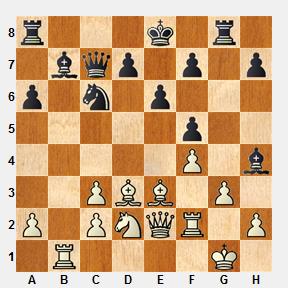Last week I looked at the longest game from the latest issue of the weekly magazine
TWIC. I enjoyed it so much that I intend to keep doing it. This week the longest game from TWIC 1112 was bizarrely a blitz game! However, seeing blitz players get an increment, and as endgames can be difficult enough to play when you have loads of time, it makes sense that players will carry on to the death in a blitz game.
In the Mind sports women's blitz event, the longest game of the week was the heavyweight encounter between Dzaganidze and Ushenina, both GM strength players. They played a 172 move marathon which featured some pretty interesting types of position. The game wasn't played perfectly, but it was blitz, and endgame novices like myself can still learn things from looking at the game. The first thing to mention is how determined and resourceful both players proved to be, white in her defence, and black in her attempts to win.
The starting position for the endgame was
Endgames with rook and minor piece are very common, and so they are worth looking at from both a theoretical and practical view point. This position sees black a pawn up, but in check. The opposite coloured bishops make the position drawish on the one hand, as it is difficult to advance pawns, but allow for attacks on the other hand, especially on the colour complex which the opponent's bishop doesn't control. For a good example of this, the game
West-Rujevic from this week's MCC Championship is worth a look.
After trading pawns, which is usually a good thing for the defender, both players moved around until the following position was reached.
White has 2 choices of retreat for her bishop: f5 defends the h3 pawn, while d3 blocks the third rank. She chose the wrong one!
61.Bd3? e4! black exploits the fact that white's bishop is pinned and it cannot take on e4 or it will get forked by Re3+. I suppose in general terms this can be explained by the fact that we want to keep our pieces active in an endgame, and self pinning a bishop is not an active way of using it. Specifically, pawn advances need to be considered at all times, so white should be aware of black's pawn advance e5-e4 at all times.
Anyway, black won white's h-pawn, but then inexplicably managed to lose her own e-pawn leaving this position.
With only one pawn left, and the corner square not controlled by black's bishop, the endgame is seemingly more drawn than before. White comes up with a simple defence. Place the bishop on the h3-c8 diagonal, sacrifice it when black's pawn eventually advances, and hold on in the pawnless endgame. This is a great resource, and one that all players should learn some knowledge of as it can save so many games.
I want to fast forward about 55 moves now. Black still hadn't moved her pawn, so technically the game was drawn under the 50 move rule. However, in blitz how can a player keep count, and claim the drawn result? But the game continued and the pawn moved, where white immediately sacrificed her bishop brining about the following position.
This position is theoretically drawn, but from a practical point of view it is worth playing on as their are winning chances. I'll show a couple of typical drawn positions and then the tragic blunder that cost white the game, after her excellent defence.
This is Cochrane's Defence. Although the defending king is cut off on the edge of the board, black can make no progress as the king is tied to defending its bishop, while the bishop is pinned.
This is called the 'Second Rank Defence'. The defender places their pieces with one square in between them on the second rank (or one file in from the side), with the defending pieces on the opposite coloured square to the bishop. Again, there is way for the attacking side to make progress without regrouping.
In our game of the week, both of these defences were used, as white's king did its best to hang on. But after 169 moves white finally cracked which goes to show that playing on in 'drawn' positions is worth it as sometimes the defender will blunder through a lack of knowledge, a lack of energy, or a simple oversight.
White's king is looking decidedly cornered, and black has the plan of playing Re5-e1 mate. This can be countered by another defence though. When Black's rook goes to the e-file, white's rook should go to the d-file preparing itself to block mate on d1. Perhaps this is what white thought when she played
170.Rh7? But from what we've already found out, just in this blog, restricting the enemy pieces is of key importance, so retaining a pin on black's bishop was the best move 170.Rb8!. This would have led to a level position, and probably hundreds of more moves unless someone was counting.
After
170.Rh7? It's mate in 2, which white executed.
170..Ba3+ 171.Kb1 Rd1 #
An amazing endgame, played in blitz time control, and one worth the time to study.





























